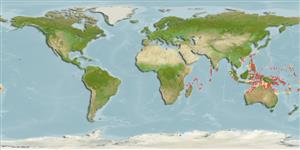Actinopterygii (ray-finned fishes) >
Perciformes (Perch-likes) >
Gobiidae (Gobies) > Gobiinae
Etymology: Trimma: Greek, trimma, -atos = something crushed (Ref. 45335). More on author: Winterbottom.
Environment / Climate / Range
Ecology
Marine; reef-associated; depth range 15 - 50 m (Ref. 90102). Tropical, preferred ?
Indo-Pacific: Chagos Islands east to Fiji, south to Australia.
Size / Weight / Age
Maturity: Lm ? range ? - ? cm
Max length : 2.4 cm SL male/unsexed; (Ref. 28618)
Dorsal
spines
(total): 6 - 7;
Dorsal
soft rays
(total): 9-10;
Anal
spines: 1;
Anal
soft rays: 9 - 11. Characterized by semi-translucent upper half of body, pinkish on lower half; most body scales with vertical yellow streak on caudal and bands/stripes on dorsal and anal; elongate second and third dorsal spine; branched 9-10 pectoral rays; fifth pelvic ray branched, about equal to length of fourth ray; forked caudal fin; longitudinal scale series 23-26; predorsal scales 2-5; cheek and opercle without scales; depth of body 4.5-4.8 in SL (Ref. 90102).
Inhabits steep outer reef slopes, often upside-down in caves, in 15-50 m (Ref. 90102).
Life cycle and mating behavior
Maturity | Reproduction | Spawning | Eggs | Fecundity | Larvae
Kailola, P.J., 1991. The fishes of Papua New Guinea: a revised and annotated checklist. Vol. III. Gobiidae to Molidae. Research Bulletin No. 41, Research Section, Dept. of Fisheries and Marine Resources, Papua New Guinea. 153 p. (Ref. 6771)
IUCN Red List Status (Ref. 115185)
CITES (Ref. 94142)
Not Evaluated
Threat to humans
Harmless
Human uses
More information
Common namesSynonymsMetabolismPredatorsEcotoxicologyReproductionMaturitySpawningFecundityEggsEgg development
ReferencesAquacultureAquaculture profileStrainsGeneticsAllele frequenciesHeritabilityDiseasesProcessingMass conversion
Tools
Special reports
Download XML
Internet sources
